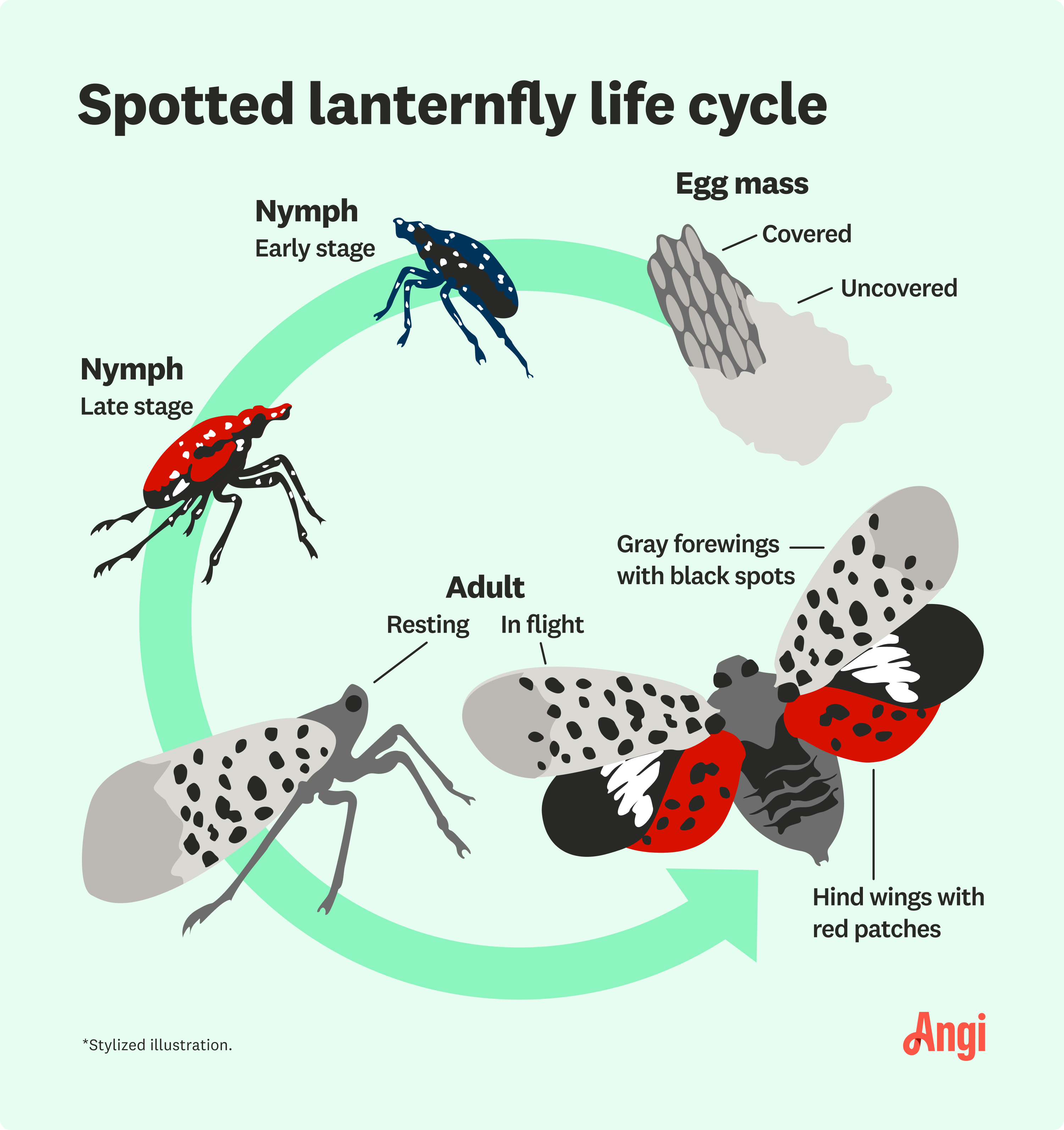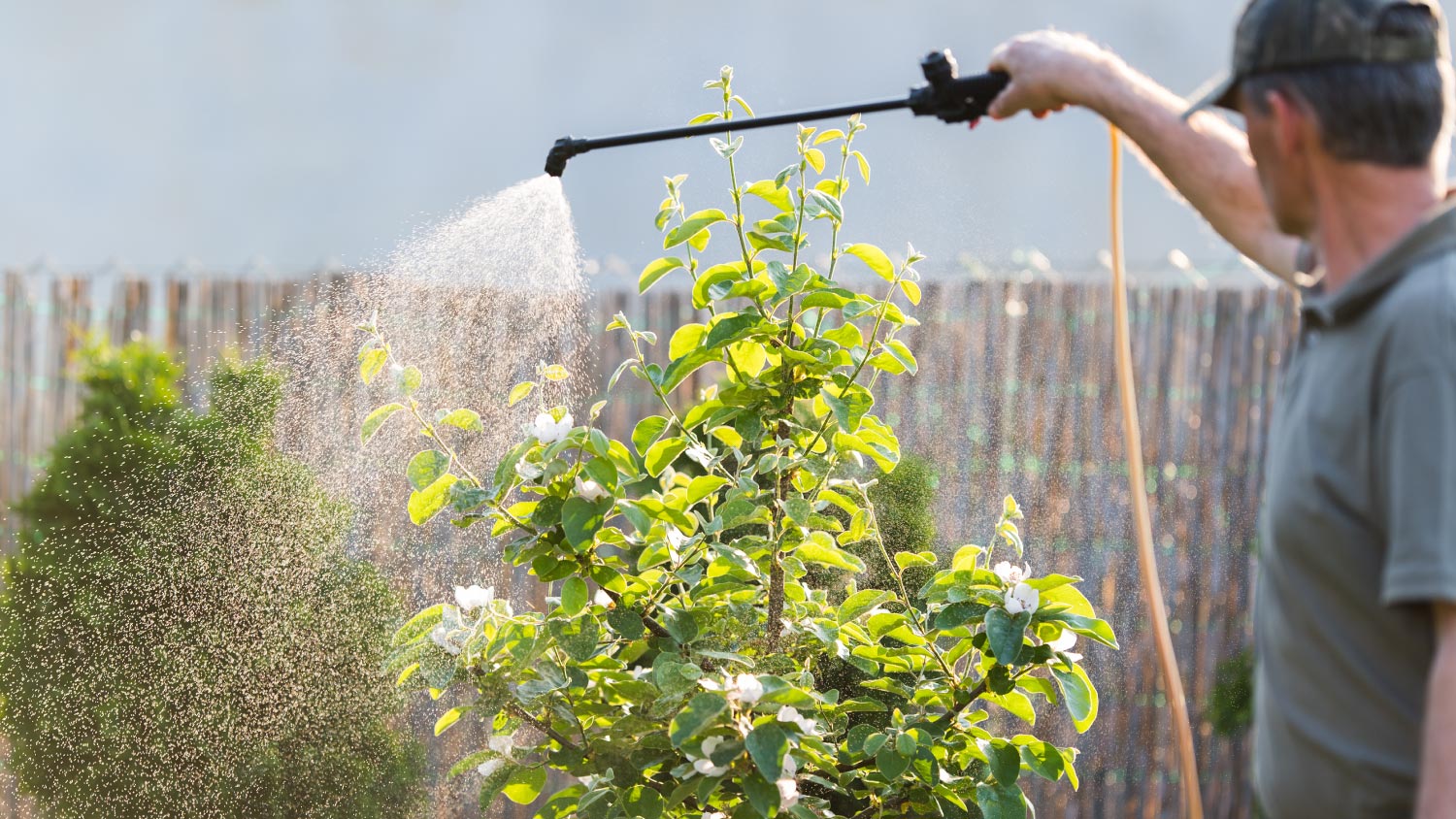
Whether you have bugs, bats, or rodents invading your home, you’ll want to contact an exterminator quickly. Find out how much pest control costs in Columbus, OH.
Shoo fly, don't bother me—or my plants


Spotted lanternflies were first observed in the U.S. in 2014.
They feed on more than 70 plant species.
Treatment measures include traps, insecticide, and egg scraping.
Spotted lanternflies are plant-hoppers native to Asia, but they were first spotted in the U.S. in 2014, according to the Animal and Plant Health Inspection Service. These pesky pests love the taste of plants, including agricultural crops and hardwood trees.
When they feed on plants too often, they can harm the plant, so it's best to get rid of spotted lanternflies if you find them in your yard. Learn everything you need to know about spotted lanternflies, including treatment, prevention, and signs to look out for.
The spotted lanternfly is a type of plant hopper native to India, Vietnam, and China. In 2014, the first instance of a spotted lanternfly was discovered in the U.S. in Berks County, Pennsylvania. Since then, the invasive species has been found in an increasing number of states, including New Jersey, Delaware, Maryland, and Ohio.
Spotted lanternflies have a healthy appetite for plants. In fact, they've been observed eating more than 70 plant species, including many agricultural crops and hardwood trees.
Lanternflies will eat the following trees, crops, and plants:
Trees of heaven
Grapevines
Black walnut trees
Willow trees
Sumac trees
Maple trees
Oak trees
Pine trees
Almonds
Apricots
Cherries
Apples
Hops
Grapes
Nectarines
Peaches
Plums
While lanternflies will eat a variety of foods, they’re particularly fond of walnuts, trees of heaven, and grapevines.
Spotted lanternflies typically lay their eggs in the fall. The eggs hatch in the spring, from late April to June. Spotted lanternflies can lay egg masses on a variety of surfaces, including trees, houses, rocks, and even outdoor equipment.
Each egg mass comprises around 30 to 50 individual eggs. After a lanternfly hatches in the spring, it experiences four nymphal stages, called instars, before reaching adulthood.
There are many reasons to control these pests. Since spotted lanternflies aren't native to the U.S., they can harm the ecosystem. Known to feed en masse on a large variety of plant species, lanternflies can harm hardwood trees, agricultural crops, and other plants, so they're not welcome guests in most yards.
Additionally, when spotted lanternflies feed on plant sap, they excrete the excess sap as liquid waste called honeydew. Honeydew attracts ants, wasps, and bees. It can also build up on the surface of plants, leading to sooty mold. Sooty mold doesn't harm plants outright, but it can block photosynthesis, ultimately deteriorating a plant's health.
Like most insects, spotted lanternflies look different depending on where they are in the life cycle.
Egg masses: Egg masses appear as a flat, gray-brown substance. They commonly appear on trees, but they're also found on rocks, small plants, fences, and outdoor furniture.
Early nymphs: Early nymphs, aka baby spotted lanternflies, feature small black bodies, relatively long legs, and bright white spots.
Late nymphs: Late nymphs, or adolescent spotted lanternflies, are about the size of a nickel with mostly red bodies and some black patches.
Adults: Adult spotted lanternflies have two sets of wings. Their hind wings have red patches, while their forewings are gray with black spots. Often, only the forewings are visible, which helps them camouflage against trees.

Several signs indicate you have spotted lanternflies in your yard, including sap streaks on trees, sooty mold, and an influx of bees and wasps.
When lanternflies feed on trees, they often leave sap streaks in their wake that are present on tree bark and sometimes have a fermented odor.
If you notice a sticky fluid around your plants' bases, you might have a lanternfly problem. After lanternflies feed, they excrete honeydew, which tends to accumulate on the base of plants and on the ground underneath infested plants.
Over time, the honeydew that lanternflies excrete builds up and can lead to sooty mold. Sooty mold appears as a dark gray or black powdery coating. You might find it on plants or on structures, such as fences and outdoor furniture.
In addition to mold growth, honeydew can lead to an influx of bees, wasps, ants, and other sugar-loving insects who like its sweet taste. If you're finding more of these insects in your yard than usual, it might be due to lanternflies.

Treatment for spotted lanternflies varies depending on their stage in the life cycle.
If you notice spotted lanternfly egg masses on any of your plants, trees, or other outdoor surfaces, you can simply scrape them away and put them on a napkin soaked in alcohol. Removing just one of these egg masses can help prevent 30 to 50 spotted lanternflies from hatching in your yard.
You can use circle traps to capture and eliminate spotted lanternflies after they hatch. Circle traps are modified funnels that you can purchase from the hardware store and apply to your trees.
These traps comprise netting that's wrapped and stapled around the tree, then attached to a funnel. The netting helps direct lanternfly nymphs into the funnel. Once in the funnel, the lanternflies can't escape.
Some people also use sticky rings around a tree as traps. However, this technique isn't generally recommended because these traps can capture and destroy all kinds of insects and critters, not just lanternflies.
You can use one of two types of insecticide treatments to kill spotted lanternflies: contact or systemic.
Contact insecticide kills pests on contact. You can spray it on any surface with suspected spotted lanternfly activity to kill them. However, it's not a preferred elimination method since insecticides can kill other organisms as well, including beneficial ones.
If you do decide to use it, you should avoid applying it to blooming plants. This will help protect pollinators, like bees, which are very helpful for the ecosystem.
Systemic insecticides are designed to move through a plant's vascular system, ultimately killing spotted lanternflies when they feed on the plant. You can apply systemic insecticide by spraying the affected tree trunk or through trunk injection, depending on the type.
Some systemic insecticides can also be applied through soil drenching or injection. Since these insecticides have harsh substances that can potentially damage your trees, it's best to hire a pro for the job.
In fact, regardless of which insecticide type you choose, it's a good idea to hire a pest control company. Insecticides often contain compounds, like dichlorodiphenyltrichloroethane (DDT), that can harm you and the environment if improperly applied. A local pro will know how to apply insecticide as safely as possible. Pest control services cost $200 to $600, on average.
Although there's no way to completely stop spotted lanternflies from making their way into your yard, there are several easy things you can do to help keep them out.
Unfortunately, spotted lanternflies aren't very picky eaters. They're known to feed on over 70 plant species. But you can avoid having their favorite foods in your yard.
If possible, limit the number of trees of heaven, grapevines, black walnut trees, and willow, sumac, and maple trees you have in your yard. You should also regularly monitor these trees for signs of spotted lanternflies.
One of the best things you can do to prevent spotted lanternflies in your yard is regular monitoring. Since they lay eggs in the fall, begin inspecting for egg masses during September and continue inspecting until the spring when they hatch.
If you find any egg masses, scrape them away and put them on an alcohol-soaked towel and call a local exterminator to help treat or eliminate the chances of an infestation.
This company does it right. Firstly, I want to say that Landan was a joy to work with. He was so kind, transparent, and had everything under control. His entire team showed up ready to work and they were all very respectful of the fact that we were in an office space. A little backstory – we...
Our office has a new lease on life, thanks to Custom Paint Jobs LLC. Outstanding work!
Window Depot did an amazing job on my deck. I wasnt sure what I wanted to do, but their composite decking was affordable and will last a long time. I am excited to have family over, and I am no longer embarrassed by my backyard. Jeff and the ground crew were polite, respectful, and caring for...
Storms Mobile Welding was great to work with. They were prompt, professional and did an overall excellent job on the project. I highly recommend.
AFS was excellent from start to finish. Jess, the sales associate, was fantastic...very knowledgeable and very professional. The installation crew was excellent. I couldn't be more pleased with the process. Best of all, my new floor looks fantastic!
We used Unique Hardwood Floor LLC three years ago to work on the floors of a 70 year old home that needed a great deal of work. Some floors needed repairs, some were replaced and others just needed to be refinished. It was a complicated job as they needed to blend the old and the new to...
While Naaman and Mike were very professional and amicable to work with, there were issues in this project that makes giving a higher rating impossible. We had several communications issues that delayed completion. The roofers accessed the property without communicating with me. Just showed up...
Mr. Pooner's company came out gave us an estimate and promised installation within 10 weeks from receipt of signed contract and deposit. Mr. Pooner obtained all the necessary licenses and began work promptly. His company's workmanship is excellent. The garage door is mounted on steel...
My 2nd floor furnace was only working sporadically and the warranty company sent Air Fast to fix the issue. They came out and shut off the furnace completely. Said they would be back the next day when they had a new flame sensor... 4 more days passed with me calling them multiple times a day...
They called 15 minutes before arrival to announce that they were coming and arrived on time. Immediately they saw the broken springs and replaced them very quickly. Jeff suggest that I put on a rope to the manual switch to operate it more easily if necessary. I explained that my old door...
From average costs to expert advice, get all the answers you need to get your job done.

Whether you have bugs, bats, or rodents invading your home, you’ll want to contact an exterminator quickly. Find out how much pest control costs in Columbus, OH.

Your mosquito misting system cost will vary based on factors such as the size, type, brand, and more. Find out what the budget for this system looks like.

If you need to get rid of bugs and pests making your home unsafe, it's time to decide if fumigation is necessary. Learn more about average fumigation costs.

With a few supplies from home, you can make a DIY flea trap that’s safe and effective. Follow these steps to a successful flea trap.

Wondering how to kill stink bugs—and keep them away, for good? Read on for a DIY guide on how to get rid of stink bugs.

Many popular cockroach treatments are harmful or annoying for pets. We’ve collected the alternatives that get rid of roaches without the same dangers.